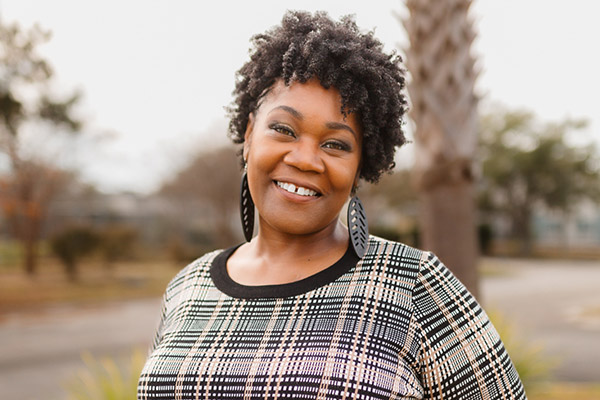07/14/2023

Are you a manual therapist with joint mobility issues? Then this episode of “I Have a Client Who . . .” is for you. And if you have a client with joint mobility issues, you’ll want to tune in too.
My colleague Natalie Pendergrass recently reached out to me to share her experiences with being diagnosed with Ehlers-Danlos syndrome (EDS).
EDS is a genetic disorder involving the formation of abnormal collagen. It occurs in 13 different identified subtypes, starting with hypermobility of joints and covering a wide spectrum of variations in connective tissue problems.
Natalie shares what it’s like to receive massage as a person with EDS, but also the special challenges of being a massage provider with EDS. She developed practices that allow her to do demanding work while protecting her joints.
Natalie also recently started some contact points for people with EDS so MTs can get more of this important information.
Check them out:


[music]
0:00:01.4 Ruth Werner: Hello, "I Have A Client Who... " listeners, Ruth Werner here, and I'm so excited to let you know that my library of online self-paced continuing education courses has just expanded. I now have a two-hour ethics course called A Doctor's Note Is Not Good Enough, And What Is Better. This NCBTMB approved course goes into why a doctor's permission or approval or even a prescription doesn't provide the legal or safety protection you might think it does. Then we look at how to start useful conversations with healthcare providers that will actually get us to safe and effective massage for our clients with complex conditions. Visit my website at ruthwerner.com for more information and to register for A Doctor's Note Is Not Good Enough, And What Is Better.
[music]
0:01:00.1 RW: Hi, and welcome to "I Have A Client Who... " Pathology Conversations with Ruth Werner, the podcast where I will discuss your real life stories about clients with conditions that are perplexing or confusing. I'm Ruth Warner, author of A Massage Therapist's Guide To Pathology, and I have spent decades studying, writing about and teaching about where massage therapy intersects with diseases and conditions that might limit our client's health. We almost always have something good to offer, even with our most challenged clients, but we need to figure out a way to do that safely, effectively, and within our scope of practice. And sometimes, as we have all learned, that is harder than it looks.
0:01:45.6 RW: For today's episode, listeners, we have a really special treat. I have been familiar with Natalie Pendergrass for a while. We're friends on Facebook and we've been sort of aware of each other. But recently, she sent me a note describing some experiences that she's going through and she's very excited about improving or increasing awareness among the massage therapy community about this issue. Now, full disclosure, I actually have done a couple of podcasts on this topic, but they are pretty old, and so we thought it was a good time for an update, especially from the point of view of a person who has both received a lot of massage, but who has also been a massage therapist for 20 years. So I'd like to introduce my friend, Natalie Pendergrass. And Natalie, can you tell us a little bit about what you have been discovering.
0:02:40.1 Natalie Pendergrass: Sure, thank you, Ruth. I have been discovering that living with Ehlers-Danlos syndrome is a lot more complicated than it is given credit for. It is definitely considered invisible illness, and there's a lot of people walking around the world with hyper mobility that causes a lot of muscle pain and tension, depression, anxiety, that is not seen in the way that it needs to be, or respected in the way that it should be. Oftentimes, we're seen as just carrying on.
[laughter]
0:03:15.7 RW: Well, and I want you to talk about how people described you during your childhood, but I wanna just interject for a moment, a little bit of technical information about Ehlers-Danlos syndrome, which is also called EDS. This is a genetic condition or a group of genetic conditions. What did we say? 13 different types? Until recently, we really didn't know about all these different types, now we have the advent of some genetic testing that allows us to be a little bit more refined. Unfortunately, as with all genetic disorders, finding it provides some answers, but those answers are not about effective treatment options. They're really more about, how can we make adjustments in our lifestyle to living with this genetic condition, which in this case, weakens the connective tissues. And so, Natalie's fascia and tendons and ligaments are more slack than you would find in someone who doesn't have EDS, and that puts her at risk for a number of different issues. So let's talk a little bit about your childhood.
0:04:17.0 NP: Yeah, so in my childhood, I realized... I don't know how I figured this out, but I realized I could partially dislocate my shoulders and I would do that for the fun of it, for entertainment. I would tell people like, "Watch this,' and I have them put their finger on my shoulder and I'd pop my shoulder out and their finger would sink into my shoulder. And they'd be like, "Eww, gross!" Like, "Wait," and I'd pop it back in and it'd pop their finger out, and they'd be grossed out and we'd all be entertained.
0:04:43.6 NP: And it wasn't until I was actually in the massage therapy program in 2002, 2003, where we were studying shoulders that day, and I went up to the teacher on break and I said, "Okay, so I'm curious that we're talking about shoulders, what do you think it is I'm doing here?" And I show him, he's like, "Wow." He's like, "You're partially dislocating." And I was like, "Okay, that's what I thought." But yeah, he confirmed, and I told a friend who also did PT, and she said, "Yes, stop doing it." I realized, yeah, it was not a good idea to continue doing into my adult life. I also had issues with trying to run or if I didn't warm up my ankles, they couldn't take any impact. I remember dropping off of the monkey bars one day, and I only had about a foot to fall maybe, and just collapsing, scream, collapse, 'cause I felt like I broke my ankle, and somebody picking me up, carrying me to the nurse, and then I was fine. And even as an adult, this still happens. If I need to run, I hopefully will have a chance to warm up my ankles because otherwise, if I have to run across street, I might drop in the middle of the street and I hobble the rest, like... [laughter] And I manage, but yeah, it's been an issue for a long time.
0:05:52.6 RW: So for your life, you have lived with this sort of general... You're not fragile, but there is a sense of instability when you make sudden demands on your body, and what that tells us is that the muscles that are supporting your joints, they have to kick in in order to keep you from dislocating. And then you told me that early in adulthood, you went through a number of incidents with neck injuries, and so you had a lot of pain, and that was sort of your introduction to massage?
0:06:23.7 NP: Yeah, in my early years of driving, I swear I was a car magnet for one year. I was rear-ended five times in one year. I swore I'd never buy another blue car because I think I just felt like blue just attracted other cars to drive into it. And each time it happened, it would be immediately. It was no big deal, it wasn't a big impact, and I'd go on about my day. By the end of the day or the next day, and then weeks following, I was in excruciating pain, I could barely move my head, my neck just felt rigid and stuck. And so I said, I've learned the protective mechanism of, "This head's gonna fall off with the way it keeps moving, so tighten everything up," is basically what my nervous system does.
0:07:08.3 RW: And for good reason, because your nervous system isn't wrong in this case, that your joints need a little more external stabilization than someone who doesn't have EDS and who has not been through a series of car accidents, and so their ligaments are a little more functional. So you started receiving a lot of massage, you ended up in massage school, can you talk to us a little bit about being a massage therapist with hyper-mobile joints?
0:07:39.0 NP: Yeah, that's a great question. So I'm really glad that right before I went to massage school, I had actually finished yoga teacher training. Because of what I learned in yoga before going into massage, I also learned how to move my body a lot better, so it was in yoga where my teacher pointed out, "Do you know what you're doing with your knee? Stop doing that." And she pointed out that I had it hyper-extended, and so I learned to straighten it. And she told me, "No, don't let it go there anymore, this is straight. Hold it at straight." And so I've gotten really good at stabilizing my knees. So I learned a lot in that class, like, and if you hold your head back here, the neck softens up. Just all sorts of different things that help me to function better. So it was awesome when then I started massage school, I just kinda kept that foundation in the back of my mind and it helped me to move better. I learned to not let my shoulder blades move up, 'cause if I put pressure on my hands, if I lean like you will on a client, it's very easy for my shoulder just to go up to my ear. But I have learned through yoga, keep those shoulder blades down, engage the muscles, hold them there. And so when I'm practicing, I am constantly getting my own workout, because I am holding my shoulder blades down and stabilizing and engaging everything in order to provide pressure to the client's body and not just receive it in my own joints.
0:08:53.3 RW: I know enough people involved in manual therapies who have joint mobility. It might be interesting if at some point you did a class in using muscles to protect your joints while being a massage therapist. If listeners are interested in such a thing, let me know and I'll hook you up with Natalie. And now, I'd like... Well, I'd like you to talk, Natalie, about why you contacted me, why you think this is such an important thing to bring to our consciousness, and to put that in the context of what this means when we provide massage therapy for clients who might be somewhere on that spectrum between hyper-mobility, that's more than we would expect, and someone who really is at that frail end of EDS.
0:09:39.8 NP: Yeah, so when I initially was receiving massage, I would go in with so much pain that I was the type of client that said, "Yes, stick your elbow in it, because the pain you're giving me feels so much better than the pain I've been in." And I left generally feeling really good, like, "Oh, I'm so relaxed, my muscles feel so much better." But unfortunately, what would happen is, sometimes it was on the drive home, my neck would tighten up, especially my neck. Probably, it was because I've had so many neck traumas, and you've got this 10-pound weight on the top of an unstable limb. [laughter] You know, on this unstable neck.
0:10:13.9 NP: So I'd kind of been doing that for a long time, unfortunately. So I was in a roll-over car accident July of '21, and that took me almost two years to recover from. So we aren't quite at July yet. I was only released from care in the last four weeks. I went through PT with three different PTs, so they're doctors, and also saw a couple different chiropractors, and did a lot of different stuff where I was always being improperly treated, because even though I would say, "I'm pretty sure I'm hyper-mobile," they just be like, "Okay," and just have me do the same things they were having everybody else do, which meant improper movements and just exacerbating the issue.
0:10:51.0 NP: So in my research and in all this trying to recover, what I've realized that I really need is, yes, I need the muscles loosened up some, but it's more like they just need to be soft and they need that edge taken off. But if too much is taken off, the muscles are put in too much of a state of weakness, fatigue, relaxation, then my nervous system will respond by getting tighter. So that's one big thing, is when your client is hyper-mobile, understanding that they need some of that tension to stay in their body, you can't just try to alleviate it all because it will create more instability and their body will basically fight back in trying to prevent your limbs from falling off. The other thing is being careful stretching clients. So I have told people, "I'm hyper-mobile," and then sometimes they'll still be pulling my arm out, and I'm literally on the table, pulling it back in, because I know that they will dislocate my shoulder. So, my massage is not that relaxing when I am trying to keep my limbs attached while you're trying to pull them off. [laughter]
0:11:53.2 RW: Wow, oh my goodness.
0:11:53.6 NP: So I do a lot less stretching with my clients, I do a lot of pin and stretch. I think that's a lot more useful where you can shorten up a muscle, pin it down, and then just give it a small range of motion. It's a little movement to the joint instead of its full range of motion, because that's what I figured out is the biggest issue, is, don't put my joints to their full range of motion, because it's way more than they should be going to. And so that's what a lot of therapists are looking for, and then they're just going, "Wow, wow, you're so flexible. Wow, I can move this so easy." I'm like, "Yeah, well, just stop." [laughter]
0:12:25.3 RW: Flexibility is not always the desired outcome. It is possible to take it too far.
0:12:33.4 NP: It is.
0:12:33.8 RW: Yeah, yeah, and I really appreciate what you say about over-treatment, and it's a drum I beat constantly, which is, let's work for incremental improvements and check on how that gets incorporated, woven into the body during the times between massages. I just don't trust those giant changes in one session because they tend to backfire. And I think for someone who lives with a nervous system that is telling their muscles that their head is gonna fall off, very, very important for us to respect that and to understand that that's there for a reason, and to try to change it in one session is just not gonna be helpful. Is there anything else that you would like to tell listeners about having Ehlers-Danlos or working with clients who have Ehlers-Danlos? What's your final sort of chance to wrap it up and take it away?
0:13:32.4 NP: Sure. Well, one thing I can say is, definitely as a massage therapist, I've had therapists say to me, "Well, I don't need to workout, my job is my workout," and that is one thing I discourage in anybody, even if you don't have hyper-mobility. But especially if you have hyper-mobility, if you have EDS, you have to exercise every day, you have to be doing core strengthening, you have to be doing things that are stabilizing your joints, and you have to put that into practice every day at your table when you are working. You can't go into a day and just let it go because you will pay for that and that will end up meaning that you're not not able to work. I have figured out that I can only see so many clients in a day, before at the end of the day, I can feel my spine, my vertebrae shifting back and forth because my muscles have now been fatigued and they can't hold it anymore. So I know that's as much as I can work in a day, and my work days have to be shortened because of that. So learning to honor your body, take care of it, do the exercises that are necessary, learn to stabilize your body. And yes, I do need to get that class written. [laughter]
0:14:36.2 RW: That would be wonderful. I really am inspired now, so I wanna put out the call to any massage therapists who feel like you're living with some level of hyper-mobility, let's create a little bit of community and get you hooked up with Natalie who has, through bitter but also sweet experience, learned how to do this in an effective and sustainable way. Natalie, thanks again for reaching out to me with your experience, and I really appreciate the chance to share that with our listeners.
0:15:08.8 NP: Yeah, thank you. Thank you so much, Ruth. It's been a pleasure.
0:15:12.3 RW: Likewise. Thank you.
0:15:13.7 RW: Hey, everybody, thanks for listening to "I Have A Client Who... " Pathology Conversations with Ruth Werner. Remember, you can send me your, "I Have A Client Who... " Stories to ihaveaclientwho@abmp.com. That's, ihaveaclientwho, all one word, all lowercase, @abmp.com. I can't wait to see what you send me, and I'll see you next time.
[music]





